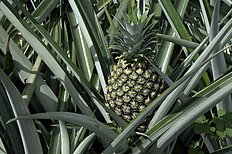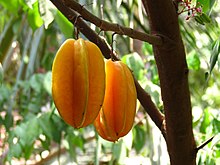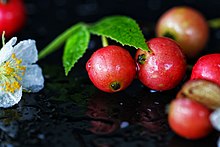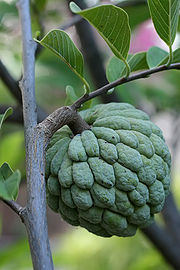User:Abbiekissel/sandbox
FRUIT TREES IN THE PHILIPPINES

- A mango is an edible stone fruit produced by the tropical tree Mangifera indica. Mango or mangga in Filipino, is the national fruit of the Philippines and are grown by around two and a half million smallholder farmers on over 7 million mango trees. It is third most important fruit crop of the country next to banana and pineapple. In Philippines alone, different varieties of mangoes grow which locals enjoy tremendously. It is not only the national fruit that represents our country but one of the most beloved fruits of the Filipinos as well. We call Mango as “Mangga”. The heart shaped of the mango which has a golden yellow color when ripe represents the “golden heart” of every Filipinos, meaning that each of us has kindness instilled in our hearts. The most common variety of mango in the Philippines is what Americans refer to as champagne mango. It is also called Manila mango, Ataulfo (named after its Mexican grower) and Honey mango. For Filipinos it is manggang kalabaw (carabao mango) while for commercial trade, the Philippine government refers to it as ‘Manila Super Mango’ and is the country’s top export variety and is considered one of the best mango varieties in the world. In the Philippines, the best mango comes from the island of Guimaras located in the Western Visayas region. They are not only considered sweetest mangoes in the Philippines but in the whole world as well.

- Pineapple (Ananas comosus) is a tropical plant with an edible fruit; it is the most economically significant plant in the family Bromeliaceae.Pineapples are one of the key crops and top agricultural commodities of the Philippines. Celebrated as a good source of vitamin C, fiber, potassium, and other nutrients, the fruit is consumed fresh or processed through canning, dehydration, and other culinary applications. The pineapple is indigenous to South America, where it has been cultivated for many centuries. The Philippines ranks second globally in total pineapple production as of 2019, according to the Food and Agriculture Organization of the United Nations (FAO). The country produced 2.74 million metric tons of pineapple, taking the next spot after Costa Rica, which generated 3.33 million metric tons. Completing the top five are Brazil, Indonesia, and Mainland China. According to the Philippine Statistics Authority (PSA), as of the first quarter of 2021, the county has produced 662.50 thousand metric tons of pineapples. The majority of these are found in Mindanao, especially in Northern Mindanao, accounting for 61-percent of the annual crop, according to the PSA. Ranking next is SOCCSKSARGEN (South Cotabato, Cotabato Province, Sultan Kudarat, Sarangani, and General Santos City) with 28-percent. Davao, Caraga, and Zamboanga are also key producers in the south. In Luzon, Bicol provides 6-percent of the total output, while CALABARZON (Cavite, Laguna, Batangas, Rizal, and Quezon), Cagayan Valley, and Central Luzon are also key producers.

- Starfruits, locally known in the Philippines as balimbing, are fruits of the carambola tree which is native to Southeast Asia. Balimbing is naturally shaped like a star and can be eaten with its skin intact. In Tagalog, the word balimbing is also slang for a traitor or a turncoat. This is because the balimbing fruit has many sides. Politicians who change parties or loyalties based on who’s currently has authority are frequently derided as balimbing. These star-shaped delights, hence the name, are known for their distinct shape and deliciously tangy fruits. Most countries refer to it as carambola and some simply refer to it as the star fruit. It is a favorite snack for communities in the Philippines and its sweet flavor is making it popular around the world. Exceptionally rich in disease-fighting vitamins and minerals, this fruit is not far from becoming the next “super-fruit”. The Food and Agriculture Organization of the United Nations (FAO) reports that the fruit crop is known to have originated in Ceylon and in the Moluccas, but has been grown mostly in Asia because of the advantageous tropical climate suitable to the growing of the plant. Having reached a number of countries, this gave rise to the fruit’s different names. In English, it is known as starfruit, carambola, and five corners. The Indonesians and Malay call it belimbing manis, while it is referred to as ma fueang among the Thais and khe among the Vietnamese.

- Durian, (Durio zibethinus), tree of the hibiscus, or mallow, family (Malvaceae) and its large edible fruit. It is a unique tropical fruit. The durian is cultivated in Indonesia, the Philippines, Malaysia, and southern Thailand and is seldom exported. Although the durian has a mild sweet flavour, it also has a pungent odour, which has been compared to that of Limburger cheese; for this reason, the fruit is banned from public transportation in some places. Durian is a unique tropical fruit. It is a large spherical fruit, roughly 15-30 centimeters long and 15-20 centimeters in diameter, and it can weigh up to 18 pounds. The custardlike pulp can be eaten at various stages of ripeness and is used in a variety of sweet and savory dishes. The seeds may also be eaten if roasted. The tree has oblong tapering leaves, rounded at the base, and yellowish green flowers borne along the older branches. The fruit is spherical and 15 to 20 cm (6 to 8 inches) in diameter. It has a hard external husk, or shell, covered with stout spines and contains five oval compartments, each filled with a cream-coloured pulp in which are embedded one to five chestnut-sized seeds. The ripe fruits are eaten by many animals and are an important part of local ecosystems.

- Soursop (Annona muricata) Guanabana or Graviola, also known as Guyabano in the Philippines, is known as large and versatile fruit. The guyabano fruit is better known in many parts of the world as the sour sop. Although it is originally from Central America and the Caribbean, it is now one of the top produced fruits in the Philippines. Its green, slightly spiky skin encloses a white, creamy pulp that carries an assortment of nutrients. Visit your local fresh food market or store to get hold of these highly nutritious and tasty fruits. Soursops are highly popular around the world, but are rarely found fresh outside of the tropical areas in which they are grown. The plant is grown as a commercial crop for its 20-30 cm /7.87-11.8 inch long prickly green fruit, which can have a mass of up to 2.5 kg/5.5 lbs. It is a small tree that grows usually less than seven meters high, and produces large fruits that are covered with soft protrusions. The guyabano trees bear fruits in 3 – 5 years after planting. They flower most months of the year but the peak of flowering is May and June, and the fruit ripens in November and December. The guyabano fruits should be harvested when they are fully matured. One of the best health benefits of this tropical fruit is the effect it has on your heart condition. Because guyabano is packed with potassium, it can help high blood pressure return to normal. It can also help you remedy heart palpitations and restore your heartbeat rhythm.

- Muntingia calabura, commonly known as aratilis or aratiles in the Philippines, has other local names such as datiles in Bicolano and manzanitas and cereza in Ilocano. Other international names of aratilis include Jamaican Cherry, Panma Berry and Strawberry Tree in English; bolania, yamanza and memizo in Spanish; kersen in Indonesian; and trungca in Vietnamese. It's small and round, similar in size and shape to a blueberry. However, the color of the fruit is more orange/red when ripe, and it contains hundreds of extremely small yellow seeds. The taste of the fruit is similar to cotton candy. Aratilis is a small tree measuring five meters to, at most, 10 meters high with spreading branches. That is why fruits are easily reached by children. Leaves are light green, oblong ovate to broadly oblong lanceolate measuring 8-13cm long and with toothed margins. White flowers are long-pedicelled, about two centimeters in diameter and solitary or in pairs. Fruits are globose, about one centimeter in diameter, smooth, light red, sweet, and with numerous tiny seeds. The tree originated in Tropical America and it was introduced during the Spanish Era in the Philippines where it was widely distributed and became thoroughly adapted. Parts of the aratilis tree can be utilized for other purposes. Leaves can be boiled to make a tea while its bark can be used to make ropes and fiber for bark skirts. Fruits can be processed into jams and juice. Its timber can also be used for light carpentry and as firewood. Even the flowers can be utilized as an antiseptic and to treat abdominal cramps.

- Nephelium lappaceum L., commonly known as rambutan in the Philippines, it comes from family Sapindaceae. It is one of the most popular fruits in South East Asia, including The Philippines. The fruit is also called ramboutan or ramboutanier in French, ramboetan in Dutch, ramboostan in India, shaotzu in Chinese, and chomchomor vaithieu in Vietnamese. The underutilized fruit is native to Malaysia and it was introduced to many tropical countries including the Philippines during prehistoric times. The tree is medium to large-sized, about 15-25 meters high. The firm soft white rambutan fruit itself is quite sweet and not so filling. Meaning, you can eat a lot! It’s soft, juicy and quite sticky if you don’t wash it from you fingers. But in the mouth it stays fresh and is very palatable. In the Philippines, flowering occurs from late March to early May while the fruiting season is from August to October. Fruits are harvested when fully ripe on the tree. In order to maintain the quality and freshness, rambutan fruits must be transported to local markets within three days of picking. The yield of rambutan may vary from year to year. Individual trees 8 years old or older can produce as much as 440 lbs or 200 kilograms in the first season, and 132 lbs. or 60 kilograms on the next season. In the Philippines, the average production per tree of 21 selections was reported to be 264 lbs. or 120 kilograms over a four year period, while the general average is only 106 lbs or 48 kilograms .Rambutan trees grow abundantly in the province of Aklan.

- Sugar-apple, also known as sugarsop, custard apple, or atis in the Philippines, this fruit is mostly grown in tropical regions like the Philippines. Custard apples originated in South America and the West Indies. They are now planted in Asia, Australia, and other tropical countries. These apples are typically heart-shaped or oval-shaped and can weigh up to 450g. They have light tan or greenish quilted-skin that turns brown as the fruit ripens. It is dark brown in colour and marked with depressions giving it a quilted appearance; its pulp is reddish yellow, sweetish, and very soft. This round, green knobby fruit with a creamy white flesh has a custard-like flavor which is why it's also called as custard apple. Atis is a very popular fruit in the Philippines, as well as in other Southeast Asian countries, such as Thailand. It is a sweet, delicious and nutritious seasonal fruit that contains Calcium, Phosphorus Beta-carotene; Ascorbic acid and fiber. Its dried seeds are also used to eradicate head lice. The dried ground seeds are mixed with two parts coconut oil and can be applied to the hair, avoid getting the oil into the eyes. Atis is high in fibers, which helps digestion, prevents constipation, and detoxifies our body. Sitafal contains many antioxidants (flavonoids, phenolic compounds, kaurenoic acid, and vitamin C) that fight free radicals associated with chronic diseases, cancer, and heart disease. The size ranges from 7 to 12 cm (2.8 to 4.7 in), depending on the cultivar. When ripe, the fruit is brown or yellowish, with red highlights and a varying degree of reticulation, depending again on the variety. The flesh varies from juicy and very aromatic to hard with an astringent taste. The flavor is sweet and pleasant, akin to the taste of 'traditional' custard.

- Lansium parasiticum, commonly known as langsat, lanzones, or longkong in English; duku in Indonesian or dokong in Terengganu Malay, is a species of tree in the Mahogany family, reaching 30 meters (98 ft) in height and 75 centimeters (30 in) in diameter. The species is native to Southeast Asia. It is chiefly grown in Malaysia, Indonesia, the Philippines, Thailand, and Brunei. Lanzones tree grows well under tropical humid environments. It is a long erect plant, which begins to yield after about 4 years of plantation and continues to produce fruits for over 100 years. Duku, longkong, paete, and Jolo are popular cultivars among the farmers. Small, yellow flowers appear from April to June, which develop into greenish berries in clusters. The fruits are ready for harvesting between August and November when their skin color turns brownish-yellow. Each lanzones berry measures about 3.5 to 4 cm in diameter with the thick, hairy outer skin. The leathery skin in raw unripe fruits emits clear milk-like resin. Inside, the segmented fleshy aril is almost gel-like, semi-translucent. It s flavor is sweet and lightly acidic like longan or lychee, juicy and refreshing. The seeds are soft, bitter, and should be discarded.

Guava (Psidium guajava L.) or Apple Guava and popularly known as Bayabas in the Philippines, is the sweet fruit which grows in tropical regions of America and Asia. The guava fruit can be eaten raw or used to flavor drinks, desserts, and sauces. The guava is believed to have originated in an area extending from southern Mexico into Central America. Guava fruit, usually 4 to 12 cm long, are round or oval depending on the species. The outer skin may be rough, often with a bitter taste, or soft and sweet. Varying between species, the skin can be any thickness, is usually green before maturity, but becomes yellow, maroon, or green when ripe and contains many small, hard seeds. The guava is rich in vitamins A, B, and C, as well as beta carotene. Guavas are widely canned and sold for export, as is guava juice, guava nectar, and guava shells, which are stewed and served as a desert in Latin America and Spanish-speaking islands of the West Indies.
SOURCE: GOOGLE
